Why There Is A Circular Valve At The Top Of Your Coffee Bag
Whether you've noticed a tiny hole or a piece of round plastic at the top of the bag of coffee you've picked up off the shelf, this opening isn't just so you can smell the caffeinated goodness inside. That valve has a purpose beyond showcasing the aroma of the coffee and armed with the knowledge of its intended use, you will be well-equipped to purchase the tastiest, freshest blends the next time your at-home coffee store is in need of replenishing.
As common as it is to squeeze the coffee bag to release the scent of the packaged coffee, that small valve also has a role in protecting the precious contents. The plastic contraption is a one-way valve, so you don't need to worry that any insect or contaminant can find its way into your beans, but the valve does let carbon dioxide escape. Gas in your coffee, you ask? Allow us to explain.
An exit strategy
Coffee typically reaches its peak a few days after the beans have been roasted, and coffeehouses packaging their own coffee don't necessarily want to wait until the end of this stage to start moving and selling their beans. Because coffee beans are packaged not long after the roasting process, the beans continue to release carbon dioxide, even after they've been placed inside sealed bags. Thanks to that circular valve, the carbon dioxide has somewhere to go without damaging the bags or the beans themselves.
Since the valve is one-directional, the beans remain protected from oxygen and moisture, and the life of the beans is prolonged. This also gives roasters flexibility and customers convenience since bags of beans aren't likely to expand on market shelves. As a result, your favorite cup of morning coffee is protected from outside elements and you can enjoy better-tasting coffee brewed fresh at home each morning.

